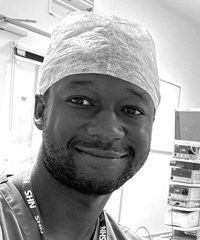ENT features
What does an Olympic medal and surgery have in common?
Competing against female Eastern Bloc athletes in the 1980s was a thankless task, demanding a mulish tenacity in an often futile cause. Ideal preparation for a career in surgery? My path to medicine was unusual, in that I left school...
Ultramarathons, frostbite and running with wolves
“I could just keep going when most sane people would stop”- the secret to success in head and neck surgery? In August 2015 I crossed the finish line of La Ultra - The High. A small camp of tents and...
The drive for success: from the hockey pitch to the surgical field
A hockey ball is rock hard and can travel at 100 mph. Stopping it with your most vulnerable body parts seems an excellent metaphor for higher surgical training... Four years on from the 2012 Olympics presents an ideal time to...
Shooting for Gold: ENT surgery and the Commonwealth Games
What are the secrets to success in your career, sports and life in general? Sharp-shooter Parag Patel hits the bullseye again. I write this article following a wave of summer sporting brilliance, from the record Great Britain 67 medal haul...
The National Bone Conducting Hearing Implant Registry
Are you an otologist with an interest in implant surgery? Is your unit on the registry? If not, you’d better have a good excuse after reading this… What is the National BCHI Registry? The National Bone Conducting Hearing Implant (BCHI)...
ENT and evidence-based medicine: How do they benefit each other?
How do we assess evidence, and how should ENT surgeons use EBM? Evidence-based medicine (EBM) is the practice of medicine based upon high quality scientific research. There are several formal definitions of EBM, the most widely quoted being that of...
Why does music move us? Music as auditory signals of emotion
Music forms an integral part of the lives of people in all known cultures around the world. In this article Dr Sandra Garrido explains that in fact, our response to music is largely innate and is related to the evolutionary...
Medical and surgical management of performing vocalists
Dr Steven Zeitels is widely recognised as the foremost laryngologist of his generation. He has been at the forefront of innovation for 25 years, and has treated innumerable high-profile singers, most recently Sam Smith and Adele. Here, he gives us...
Tone deafness and perfect pitch
If you think you are tone deaf, do not despair. Singing tuition should help but it is probably too late to hope to develop perfect pitch. Consultant otolaryngologist and keen musician, Chris Aldren, discusses the complex and fascinating subject of...
A new hearing health scheme for musicians
Joe Hastings, Health & Welfare Manager for Help Musicians UK, discusses the results of the charity’s 2015 survey of musicians’ hearing and plans for a new scheme which will give all professional musicians in the UK affordable access to specialist...
Why is a Raven like a writing desk? Some reflections on countertenors and castrati
The countertenor voice has seen a resurgence in popularity in the last 50 years. Nicholas Clapton is one of the foremost performers and teachers of his generation, and he tells us here about the link between countertenors and the (fortunately...
The sound of music for adult cochlear implant recipients
Dr Valerie Looi has dedicated her academic career to investigating music perception in people who have cochlear implants, and more recently, the potential of music training for improving their music perception. This article outlines current research relating to music perception...




















